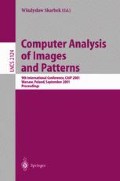Abstract
We report on pattern recognition algorithms in discriminant analysis, which were used on Laser Induced Breakdown Spectroscopy (LIBS) spectra (intensity of signal against wavelength) for metal identification and sorting purposes. In instances where accurate elemental concentrations are not needed, discriminant analysis can be applied, to compare and match spectra of “unknown“ samples to library spectra of calibration samples. This type of “qualitative“ pattern recognition analysis has been used here for material identification and sorting. Materials of different matrix materials (e.g. Al, Cu, Pb, Zn, vitrification glass, steels, etc.) could be identified with 100% certainty, using Principle Component Analysis and the Mahalanobis Distance algorithms. The limits within which the Mahalanobis Distance indicate a match status of Yes, Possible or No were investigated. The factors, which dictate these limits in LIBS analysis, were identified - (i) spectrum reproducibility and (ii) the sample-to-sample homogeneity. If correctly applied the combination of pattern recognition algorithms and LIBS provide a useful tool for remote and in-situ material identification problems, which are of a more “identify-and-sort” nature (for example those in the nuclear industry).
Access this chapter
Tax calculation will be finalised at checkout
Purchases are for personal use only
Preview
Unable to display preview. Download preview PDF.
References
Majidi, V., Joseph, R.: Spectroscopic applications of laser-induced plasmas. Crit. Rev. Anal. Chem. 23 (1992) 143–162.
Radziemski, L.: Review of selected analytical applications of laser plasmas and laser ablation 1987-1994. Microchem. J. 50 (1994) 218–243.
Leis, F., Sdorra, W., Ko, J.B., Niemax, K.: Basic investigation for laser microanalysis: I. Optical emission spectroscopy of laser produced sample plumes. Mikrochim. Acta II (1989) 185–199.
Samek, O., Beddows, D.C.S., Kaiser, J., Kukhlevsky, S., Liška, M., Telle, H.H., Young, J.: The application of laser induced breakdown spectroscopy to in situ analysis of liquid samples. Opt. Eng. 39 (2000) 2248–2262.
Beddows, D.C.S.: Industrial application of remote and in situ laser induced breakdown spectroscopy. Ph.D. Thesis, University of Wales Swansea (2000).
Davies, CM., Telle, H.H., Montgomery, D.J., Corbett, R.E.: Quantitative analysisusingremotelaser-inducedbreakdownspectroscopy(LIBS). Spectrochim. Acta B 50 (1995) 1059–1075.
Author information
Authors and Affiliations
Editor information
Editors and Affiliations
Rights and permissions
Copyright information
© 2001 Springer-Verlag Berlin Heidelberg
About this paper
Cite this paper
Samek, O., Krzyžánek, V., Beddows, D.C.S., Telle, H.H., Kaiser, J., Liška, M. (2001). Material Identification Using Laser Spectroscopy and Pattern Recognition Algorithms. In: Skarbek, W. (eds) Computer Analysis of Images and Patterns. CAIP 2001. Lecture Notes in Computer Science, vol 2124. Springer, Berlin, Heidelberg. https://doi.org/10.1007/3-540-44692-3_54
Download citation
DOI: https://doi.org/10.1007/3-540-44692-3_54
Published:
Publisher Name: Springer, Berlin, Heidelberg
Print ISBN: 978-3-540-42513-7
Online ISBN: 978-3-540-44692-7
eBook Packages: Springer Book Archive

